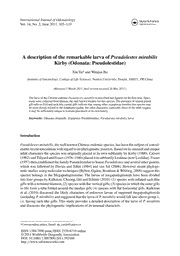
A description of the remarkable larva ofPseudolestes mirabilisKirby (Odonata: Pseudolestidae) PDF
Preview A description of the remarkable larva ofPseudolestes mirabilisKirby (Odonata: Pseudolestidae)
InternationalJournalofOdonatology Vol.14,No.2,June2011,105–110 A description of the remarkable larva of Pseudolestes mirabilis Kirby (Odonata: Pseudolestidae) XinYu*andWenjunBu InstituteofEntomology,CollegeofLifeSciences,NankaiUniversity,Tianjin,300071,PRChina (Received3March2011;finalversionreceived26May2011) ThelarvaoftheChineseendemicPseudolestesmirabilisisdescribedandfiguredforthefirsttime.Speci- menswerecollectedfromHainan,theonlyknownlocalityforthisspecies.Thepresenceofventralpaired gilltuftsonS10andsack-likecaudalgillsindicatethatamongotherzygopteranfamiliesthisspeciesmay bemostcloselyrelatedtotheAmphipterygidae,butothercharacters,especiallythoseoftheadultsuggest itmaybesufficientlyuniquetowarrantplacementinitsownfamily. Keywords: Odonata;dragonfly;Zygoptera;Pseudolestidae;Pseudolestesmirabilis;larva Introduction Pseudolestesmirabilis,thewell-knownChineseendemicspecies,hasbeenthesubjectofconsid- erablerecentspeculationwithregardtoitsphylogeneticposition.Basedonitsunusualandunique adultcharactersthespecieswasoriginallyplacedinitsownsubfamilybyKirby(1900).Calvert (1902)andTillyardandFraser(1938–1940)placeditinsubfamilyLestinae(nowLestidae).Fraser (1957)thenestablishedthefamilyPseudolestidaetohousePseudolestesandseveralothergenera, whichwasfollowedbyDaviesandTobin(1984)andvanTol(2006).Howeverrecentphyloge- neticstudiesusingmoleculartechniques(Bybee,Ogden,Branham&Whiting,2008)suggestthis speciesbelongsintheMegapodagrionidae.Thelarvaeofmegapodagrionidshavebeendivided intofourgroupsbyKalkman,Choong,OrrandSchütte(2010):(1)specieswithinflatedsack-like gillswithaterminalfilament;(2)specieswithflatverticalgills;(3)speciesinwhichtheoutergills inlifeformatubefoldedaroundthemediangill;(4)specieswithflathorizontalgills.Kalkman et al. (2010) discussed the likely characters of unknown larvae of supposed megapodagrionids (includingP.mirabilis)andsuggestedthatthelarvaofP.mirabiliswouldfallintoabovegroup1, i.e.havingsack-likegills.ThisstudyprovidesadetaileddescriptionofthelarvaofP.mirabilis anddiscussesthephylogeneticimplicationsofitsunusualcharacters. *Correspondingauthor.Email:[email protected] ISSN1388-7890print/ISSN2159-6719online ©2011WorldwideDragonflyAssociation DOI:10.1080/13887890.2011.592486 http://www.informaworld.com 106 X.YuandW.Bu Areaandmethods Larvaewerefoundinbothshadyandopenmontanestreamswithshallowwaterandstonysub- stratesinDiaoluoshanandBaiwangling,Hainan,China.Adultswerepresentaroundthesiteand atnearbystreamsinmoderatenumbers.Larvaewerecollectedusingadipnetwithremovalof bigstonesbyhand.Thoughvegetationofthesurroundingareawasalsosearchedthoroughlytoa heightof2m,exuviaewereonlyfoundonstonesextendingabovethestreamsurface.Attempts weremadetorearcollectedlarvaeinthelaboratoryinplasticcontainersbutfailed.Livingphotos were taken in the field before or just after collecting with a digital camera (Canon Power Shot A710).CharacterphotosweretakeninthelaboratoryusingDiagnosticSpotCCDcameraadapted tothestereomicroscopeNikonSMZ1000.Specimensexcepttheexuviaewerepreservedinabso- lute ethanol and were examined and dissected under a stereo microscope Olympus C011. The dorsalhabitusphotograph(Figure1a)wassuppliedbyHaomiaoZhang. DescriptionofLarvae Pseudolestesmirabilis(Figures1–3) Materialexamined 1(cid:2)exuviae,Diaoluoshan,Hainan,China,1June2007,XinYuleg.;1(cid:3),Baishuiling,Diaoluoshan, Hainan,China,29May2007,Ji-MengHualeg.;1(cid:2),Bawangling,Hainan,China,9June2007, Ji-MengHualeg. Diagnosis Arobustzygopteranwithalargehead,shortlegsandsack-likegills.Atuftofabdominalgillsis present ventrally on the final segment (Figure 1a). Ground colour of body dark brown, lacking distinctbandsormarks. Description Head. Relatively broad, exceeding maximum breadth of mesothorax; in dorsal view general shapeacompressedpentagon,withtheposteriorsidedeeplyexcavatedtoformaroundedmargin. Postocularlobessomewhatswollen.Antennae7-segmented,moderatelylongandevenlytapered, segmentsofequallengthexcepttheapicalone,whichisjusthalfthelengthofothersandincon- spicuous.Labium(Figure2a)elongate;prementumabout1.7timesaslongasbroadandbasally narrow. Distal lobe moderately convex with strong marginal crenulations; median cleft short. Labialpalp(Figure2a,b)robust,lackingsetae;distallywithtwostrong,short,incurvedteethand smallshortsecuriformprocessontheinnermarginjustbasadofinnertooth;movablehooklong androbust.Maxilla(Figure2g–j)twiceaslongasbroad.Galeaandlaciniapartlyfused;lacinia terminatinginfourlongsharpspines,formingacurved,inward-directed,pitchfork-likestructure; galeawiththreeshorterspinesdirectedupward.Palpwithshortbasalsegmentandasinglelong banana-shapedterminalsegment,reachingtobaseofmostdistalspinesongaleo-lacinia,covered indenselongsetaeforthedistaltwo-thirdsofitslength.Rightmandible(Figure2c–d)withfour welldevelopedincisorsandafifthinnermosttooth;outermost(ventral)toothwithsmallsecondary toothwellbeforeitsapex;molarcrestproducedtoformawell-definedcurvedbifidspine(thus,in theterminologyofM.C.Watson[1956],R12344’yab).Leftmandible(Figure2e–f)withsimilar ThelarvaofPseudolestesmirabilis 107 Figure 1. (a)LarvalhabitusofPseudolestesmirabilis,finalstadiumfemale,photobyHaomiaoZhang;(b)finalstadium male,ventralviewofendofabdomenshowinggilltufts;(c)F-1stadiumfemale,ventralviewofendofabdomenshowing gilltufts. incisors;molarcrestproducedstraight,withdistaledgeserratedwithsevenfinecusps(L12344’ ya(m1,2,3,4,5)b). Thorax. Prothorax robust; anterior one quarter rather narrow but posterior to this strongly expanded laterally with paired, solid, blunt processes around the midpoint of the margin. Meso- and metathorax irregular, rounded, sub-rectangular in shape. Legs moderately short and strong,bearingscatteredshortspinesandhairs,lackingbandsorothermarks;legsprogressively slightly longer from pro- to metathorax. Wing pads moderately long, flat and narrow, almost reachingtodistalmarginofS7inspecimenwithrelativelycontractedabdomen(Figure1a). Abdomen. Robustandelongatewithpaired,possiblyretractable,gilltuftsontheventerofS10. Gonapophyseswelldevelopedinmale,projectingfromanteriormarginofS9toalmosttheendof thissegment(Figure1b).InfemaleoutergonapophysesprojectingfromanteriormarginofS9to middleofS10;innergonapophysesreachingstillfurther(Figure1c).Cerciwhollyconcealedby expandedgilltuftsinventralview(Figure1a,b).Inflatedsack-likecaudalgillscoveredinshort, stoutsetae;football-likeinthefinallarva(Figure1)withbluntapicalprojections,slightlylonger 108 X.YuandW.Bu Figure 2. LarvalcharactersofPseudolestesmirabilis:prementumandlabialpalps,(a)dorsalviewand(b)ventralview; leftmandible,(c)dorsalviewand(d)ventralview;rightmandible,(e)dorsalviewand(f)ventralview;leftmaxilla,(g) dorsalviewand(h)ventralview;rightmaxilla,(i)dorsalviewand(j)ventralview. Figure 3. LeftlateralcaudalgillofF-1stadiumfemale.Left,outerview;right,innerview. and finger-like in the earlier instar larva (Figure 3); each lateral gill c.1/5 of total body length excludingantennaewiththemedianonedistinctlylonger;overallcolourratherdarkwithoutany pattern. ThelarvaofPseudolestesmirabilis 109 Microhabitatandbehaviour Larvae were found in both shady and open montane streams with stony substrates. Some even occurredinverysmall“puddles”coveredwithdensevegetationformedbydiscontinuousstreams. Theyusuallywerefoundconcealedamongstonesorgravel.Adultscanbefoundinmostareasin Hainan;however,aslarvaearelessconspicuousthanadultstheyareundoubtedlyunder-sampled. Emergence is from late March to early May. The larvae creep onto the surface of stones just 10–20cmabovethewaterwheretheyemerge. Discussion LarvaofP.mirabilispossesspairedgilltuftswhichstronglyresemblethoseofamphipterygids (Corbet, 1999; Novelo-Gutiérrez, 1995; J.A.L. Watson, 1966). It is not clear if the gills are retractable, but it is very probable they are, as described in Devadatta argyoides (Orr, 2008). If so, it would seem very probable that the organs are homologous autapomorphies. Elsewhere in the Odonata abdominal gills occur only in larvae of Euphaeidae and Polythoridae (Corbet, 1999; Sisby, 2001). These are simple finger-like ventral-to-lateral projections along much of the abdomen (not S10) and probably evolved independently. They are quite unrelated to the gill tufts of Pseudolestes. If closer examination of these should prove them to be essentially the same as the structures known from Amphipterygidae, it would be strong evidence for a shared ancestry.Although the adult characters of P. mirabilis are quite different from those of known amphipterygids, the species is so aberrant and has proved so difficult to place that its adult characters may simply be the result of rapid evolution and adaptation associated with its extraordinaryagonisticdisplays(Reels,2008).Inanycase,ithasprovenverydifficulttoplace this species by analysis of adult characters, as evidenced by the variety of suggestions as to itsrelationships(Lestinae[Tillyard&Fraser1938–1940];Pseudolestidae[Fraser,1957;Davies &Tobin, 1984; vanTol, 2006]; and Megapodagrionidae [Kalkman et al., 2010]). However the presence of gill tufts convincingly separates it from the Megapodagrionidae.Also, in view of the new larval characters, the phylogenetic position of P. mirabilis close toAmphipterygidae, recovered in one cladogram based on traditional characters by Rehn (2003), seems the most convincing. Further studies, especially comprehensive molecular analysis, may recover a clear relationship between Pseudolestidae and Amphipterygidae. Presently, we believe P. mirabilis shouldremaininitsownfamily,Pseudolestidae. Acknowledgements WewouldliketothankDrDaweiHuangforprovidingthechanceforHainanexploration.WeacknowledgeDrMatti HämäläinenandDrK.D.P.Wilsonforthevaluablediscussiononthislarva.WethankHaomiaoZhangforproviding thevaluedphotoandinformationonthelarva.WearealsogratefulforDrA.G.Orrforreviewingthemanuscriptand providingvaluablecommentsandsuggestions.ThisprojectwassupportedbytheNaturalScienceFoundationofChina (No.J0930005andNo.30725005). References Bybee,S.M.,Ogden,T.H.,Branham,M.A.,&Whiting,M.F.(2008).Molecules,morphologyandfossils:acomprehensive approachtoodonatephylogenyandtheevolutionoftheodonatewing.Cladistics,24,477–514. Calvert,P.P.(1902).OnthesystematicpositionofThaumatoneurainopinata,McLachlan(orderOdonata),withsome remarksontheclassificationofthesuborderZygoptera.Entomologist’sMonthlyMagazine,38,29–32. Corbet,P.S.(1999).Dragonflies:behaviorandecologyofOdonata.Ithaca:CornellUniversityPress. Davies,D.A.L.,&Tobin,P.(1984).TheDragonfliesoftheWorld(Vol.1).Utrecht:SocietasInternationalisOdonatologica RapidCommunications(Supplements)No.3. Fraser,F.C.(1957).AreclassificationoftheorderOdonata.Sydney:RoyalZoologicalSocietyofNewSouthWales. 110 X.YuandW.Bu Kalkman,V.J.,Choong,Ch.-Y.,Orr,A.G.,&Schütte,K.(2010).RemarksonthetaxonomyofMegapodagrionidaewith emphasisonthelarvalgills(Odonata).InternationalJournalofOdonatology,13,119–135. Kirby,W.F.(1900).OnasmallcollectionofOdonata(dragonflies)fromHainan,collectedbythelateJohnWhitehead. AnnalsandMagazineofNaturalHistory,7,530–539. Novelo-Gutiérrez,R.(1995).ThelarvaofAmphipteryxandareclassificationofAmphipterygidaesensulatobasedupon thelarvae(Zygoptera).Odonatologica,24,73–87. Orr,A.G.(2008).EightdaysinPeninsularMalaysia-andthebenefitsofhindsight.Agrion,12,24–27. Rehn,A.C.(2003).Phylogeneticanalysisofhigher-levelrelationshipsofOdonata.SystematicEntomology,28,181–239. Reels,G.(2008).ThePhoenixDamselfly(Pseudolestesmirabilis)ofHainanIsland,China.Agrion,12,44–45. Silsby,J.(2001).Dragonfliesoftheworld.Washington:SmithsonianInstitutionPress. Tillyard,R.J.,&Fraser,F.C.(1938–1940).AreclassificationoftheorderOdonata.AustralianZoologist,9,125–169, 195–221,359–390. vanTol,J.(2006).Globalspeciesdatabase.Odonata.InBisby,F.,Ruggiero,M.A.,Roskov,Y.R.,Cachuela-Palacio,M., Kimani,S.W.,Kirk,P.M.,Soulier-Perkins,A.,&vanHertum,J.(Eds.),Species2000&ITIScatalogueoflife,2006 annualchecklist.(updatedversionpublishedin2008).Retrievedfromhttp://www.odonata.info. Watson,J.A.L.(1966).ThestructureandfunctionofthegilltuftsinlarvalAmphipterygidae(Odonata:Zygoptera).Journal ofMorphology,120,9–21. Watson,M.C.(1956).Theutilizationofmandibulararmatureintaxonomicstudiesofanisopterousnymphs.Transactions ofAmericanEntomologicalSociety,81,155–209.
